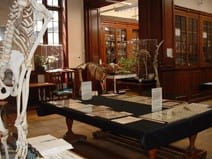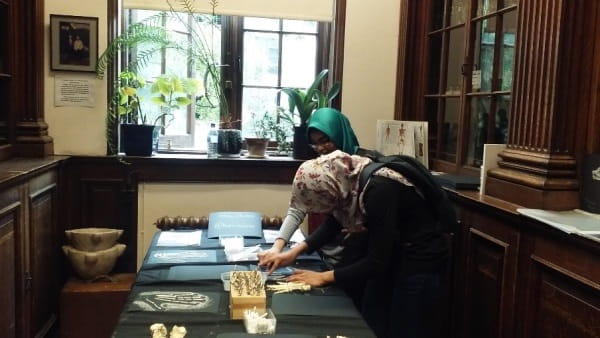Collections on the Move: partnership projects with the Museum of Life Sciences at Kings College London
09 Mar 2018
Hayley Kruger
How do you engage with a museum’s collections if the museum is closed?
This is the question that our engagement team is addressing during the closure of the Hunterian and Wellcome Museums and the storage of all RCS collections – Museum, Archives and Libraries – until the college building redevelopment is completed in late 2020. The answer to this is of course, partnership work: making connections with museums and institutions with similar collections, and developing joint events with them or re-tooling existing events to work within their spaces and collections.

Thanks to previous contact with our odontological curator Carina Phillips, the curator there, Dr Gillian Sales, was very happy to be involved when we approached her to suggest a partnership. Gillian is the sole staff member, doing amazing work with a small number of devoted volunteers with a diverse skill-set. We offered to support them in running more events to demonstrate the engagement potential of their collections, using our own experience of arranging, promoting and delivering of events.
As a pilot, we worked with them on their annual summer open day that offered visitors the chance to view the museum, follow a self-led trail of the displays and take part in some drop-in object-handling activities. This event is aimed at younger visitors accompanied by their parents so, as part of the day, we delivered a simple art activity called “Making an X-ray”, where visitors used white crayon or chalk on black paper to draw round their hand (or foot - if they wanted!) and then filled in the bone structure using cotton buds. We provided examples of x-ray images of human and non-human hands and feet to demonstrate how similar the bone structure can be in both. The activity went down enormously well with both accompanied children and unaccompanied adults!
The success of this led us to propose another session for the half-term holidays: “Long in the Tooth”. This session was developed by our previous curator of odontology, Milly Farrell, and retired dental surgeon and author of Nothing but the Tooth, Dr Barry Berkovitz. It utilised a dedicated handling collection of skulls and teeth and was designed to demonstrate how the structure and development of teeth differ across multiple species – often related to diet and environment. Barry delivered the session during the school holidays to families with children aged 11-14 years.
Barry teaches at the King’s dental school, so was really pleased that we were partnering with the museum on campus. In the workshop, we allow pre-booked family parties to carefully handle a selection of crania, mandibles and individual teeth from across the animal world. These include sharks, lions, cats, dogs, sheep, horses and pigs. The human aspect of the activity is provided by the head of our trusty resin teaching skeleton… to avoid issues of combining human remains with non-human.
The beauty of holding this workshop at the King’s museum is that, once again, participants are surrounded by further examples of diversity in the animal kingdom. Where our own collection, which relies on smaller specimens for portability, is incomplete, Gillian can provide additional and larger skulls and teeth from her own collections.
Since then we have held one initial session during the October 2017 half-term, which garnered a great deal of positive feedback, and a really successful second session, led entirely by Carina and Gillian in Barry’s absence, was delivered as part of the February 2018 half-term. We plan to continue to deliver handling workshops in the forthcoming half-term holidays, and will contribute activities to their open days in the future, as well as joint programming for “Biology Week”.
As with all projects, the session will adapt and change as we work out how we can best combine the use of our own collections and start to further incorporate the King’s collections.
We look forward to a positive partnership over the next three years and the opportunities it will bring to work with our existing audiences – and bring in new ones as well.
Find out more about the Museum of Life Sciences.
Join the RCS Museums’ mailing list for regular events e-shots for these and other partnership activities.
All photographs courtesy of the Museum of Life Sciences, KCL.
Hayley Kruger, Acting Head of Learning and Access


